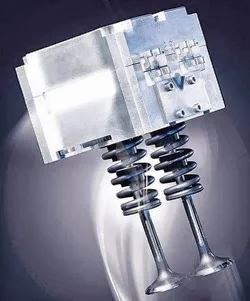Since the invention of internal combustion engines, camshafts have been used to operate the valves on the cylinder head to bring in air and fuel and expel exhaust gases. The conventional valve train has its limitations: the single lobed cam is designed to operate the valves at only specific periods of the
Otto cycle, thus preventing the engine from achieving maximum torque at higher RPMs. The opening and closing of the valves are constrained by the geometry of the cam profile. The concept of camless engines allows for greater optimization of overall engine performance during different phases of running.
Otto cycle, thus preventing the engine from achieving maximum torque at higher RPMs. The opening and closing of the valves are constrained by the geometry of the cam profile. The concept of camless engines allows for greater optimization of overall engine performance during different phases of running.
Preview of camless engines ppt
Transcript
Camless Engines2. Introduction The new emerging technology for automotive technology is the Camless engine which the engine does not have camshaft to lift both intake and exhaust valve.
3. CAMS • Control the breathing channels(valves) of an IC engine • Connected to the camshaft which is operated by crankshaft • Cams push open valve sat proper time& guide their closure • But they are inflexible except VTEC & VVT-I • Engineers could not vary timing, lift & duration of valve opening infinitely
4. CAMLESS ENGINES • Eliminated mechanical linkages • Could provide an infinite variety of valve parameters • It can make engines clean, efficient & responsive
5. Working Of Conventional Engines • The crankshaft turns camshaft which operates valves by mechanism • Spring brings back valve to initial position • Timing of engine valves depends on the shape of cams
6. Conventional Engine Valves
7. • Engineers must design cams in the development stages • This design compromises/n engine power & fuel efficiency • Considering this compromise automobile company brought variable valve timing mechanisms • But are effects were limited
8. Camless engines overview • Main sensors- Engineload sensor Exhaust gassensor Valveposition sensor Enginespeed sensor ELECTRONIC CONTROL UNIT SENSORS ACTUATORS
9. • Sensorssenseparameters& send signals to ECU • ECU contains microprocessors with associated software • ThisECU controls the actuators to work according to requirements
10. Actuators • It is an electro-hydraulic camless valve train (ECV) Useselastic property of a compressed hydraulic fluid which acts like a liquid spring, accelerates& decelerates the valves
11. Hydraulic pendulum • Involvesconversion of PE to KE and back to PE with minimum energy loss • During acceleration of valves PE is converted to KE • During deceleration of valve energy of moving valve is returned to the fluid
12. Detailed view of Hydraulic Pendulum
13. Operation of the hydraulic pendulum
14. • Lift, timing & duration of valve opening is varied by controlling solenoid valves • Thisisdoneby ECU when signals are sent from the sensors
15. Modifier Rod • Used to impart Unequal lift to the paired valves Zero motion to any valve
16. Modifier Rod Operation
17. Advantages • Enablesthedevelopment of higher torque throughout the entire rev range which in turn improves fuel economy • Cylinder Deactivation can be achieved during the idling phase • Exhaust gas recirculation is improved • Reduces friction losses • Reducestheinertiaof moving parts
18. Resultant Advantages • Better fuel economy- 7 to 10 % increase • Higher torque& power- 10 to 15 % increase • Lower exhaust emissions- EGR system iseliminated sinceEGR effect occurson itsown & thusreducesNOx emissions • Reduction in size& weight
19. Disadvantages • High Cost • Increased power consumption • Air gap between the solenoids may demand a higher magnitude of current during certain periods • The control strategy for valve seating velocity needs to be modified
20. Conclusion Even though some disadvantages are present, we can expect electrohydraulic & electromechanical valves to replace the conventional camshaft technology.
21. References • http://www.cvel.clemson.edu/auto/AuE835_Projects_2011/Shroff_project.h • http://en.wikipedia.org/wiki/Camless • http://www.autospeed.com/cms/article.html?&A=0910
22. Thanks


0 comments